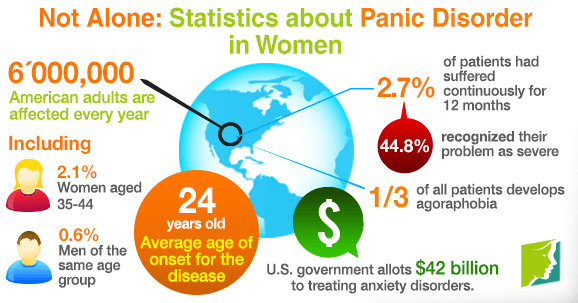Due to its internal nature and varied range of symptoms, panic disorder can feel isolating to those who deal with it every day. It is helpful, to know therefore that millions go through similar trials and tribulations and come out triumphant on the other side. Read on to learn about current panic disorder statistics that can put things in perspective and inspire you to get the help you need today.
6 Million
Current statistics about panic disorder suggest that approximately six million American adults are affected every year by the condition, equivalent to slightly less than the population of Philadelphia. Women, incidentally, are twice as likely as men to experience the condition, as it is a possible side effect of hormonal imbalance and menopause.
2.1%
Among women aged 35-44, the statistics show that the rate of panic disorder is around 2.1%, compared to 0.6% among men of the same age group. Though the likelihood of experiencing chronic panic attacks decreases for both sexes over time, the rate of decline for men is much more drastic.
2.7%
The National Institute of Mental Health (NIMH) has found that, as recently as 2005, 2.7% of US adults had suffered from panic disorder on a continual basis for 12 consecutive months. Of that quantity, 44.8% - close to half - recognized the problem as severe.
24 Years
Despite a possible correlation between menopausal symptoms and panic disorder, statistics also point to the 24th year as the average age of onset for the disease. Though several additional factors come into play, and every case is different, the early twenties appear to be the most prevalent time for the condition to assert itself.
One-Third
Of those who go through the trials of panic disorder, as many as one-third of those affected are so severely influenced that they become housebound. This crosses into the territory of agoraphobia, or the fear of going outside. Therapy is often needed to allay intense fears, but research continues into other potential treatment methods.
$42 Billion
Every year, the U.S. government allots $42 billion USD to the treatment of anxiety disorders, accounting for a full third of the total mental health budget.
The statistics surrounding panic disorder can seem staggering, but it is important to realize that this condition is a normal occurrence that can, and does, happen to anyone.
For further information on managing panic disorder, click on the link below.
Sources
- Leskin, G.A. & Sheikh, I.J. (2004). Gender Differences in Panic Disorder. Psychiatric Times. Retrieved from http://www.psychiatrictimes.com/articles/gender-differences-panic-disorder
- National Institute of Mental Health (NIMH). (2013). Panic Disorder. Retrieved October 21, 2013, from http://www.nimh.nih.gov/health/topics/panic-disorder/index.shtml
- National Institute of Mental Health (NIMH). (2013). Panic Disorder Among Adults. Retrieved October 21, 2013, from http://www.nimh.nih.gov/statistics/1PANIC_ADULT.shtml


